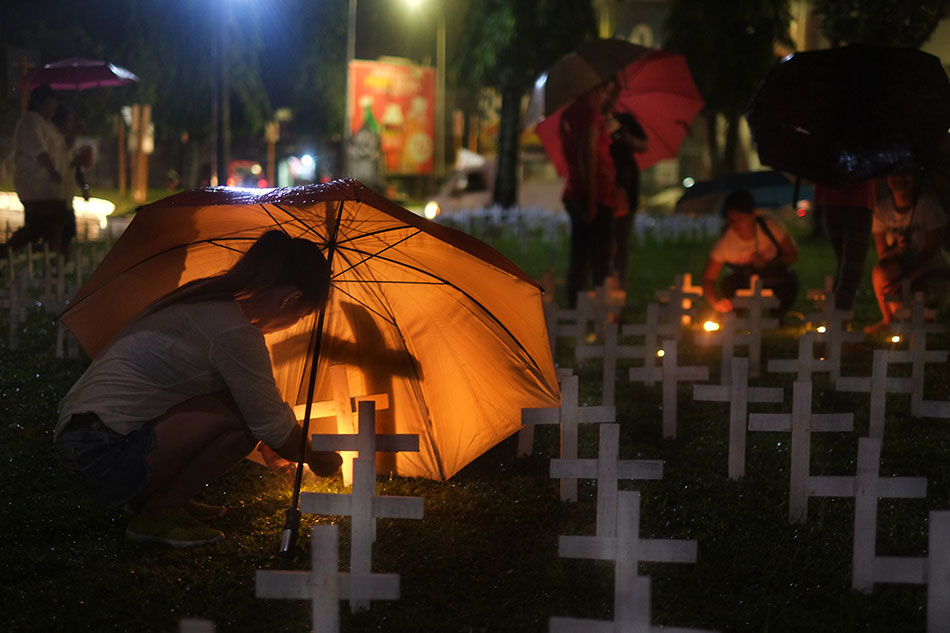Why super typhoon Yolanda was so deadly | ABS-CBN
ADVERTISEMENT

Welcome, Kapamilya! We use cookies to improve your browsing experience. Continuing to use this site means you agree to our use of cookies. Tell me more!
Why super typhoon Yolanda was so deadly
Why super typhoon Yolanda was so deadly
Cecil Morella,
Agence France-Presse
Published Nov 05, 2018 06:57 PM PHT
|
Updated Nov 05, 2018 07:18 PM PHT
MANILA - When Super Typhoon Haiyan struck in 2013 it was the disaster-prone Philippines' worst storm on record, with 7,350 people dead or missing.
MANILA - When Super Typhoon Haiyan struck in 2013 it was the disaster-prone Philippines' worst storm on record, with 7,350 people dead or missing.
Several factors caused the staggering death toll:
STRONGEST STORM
With gusts exceeding 305 kilometers (190 miles) per hour at first landfall, Haiyan was the strongest ever to hit land at the time. Typhoons more commonly reach peak velocity while still travelling over oceans.
With gusts exceeding 305 kilometers (190 miles) per hour at first landfall, Haiyan was the strongest ever to hit land at the time. Typhoons more commonly reach peak velocity while still travelling over oceans.
The powerful front drove a giant wall of seawater called a storm surge, estimated to be 7.5 meters (24.6 feet) high, into coastal towns like Tacloban, a city of 240,000 people.
The powerful front drove a giant wall of seawater called a storm surge, estimated to be 7.5 meters (24.6 feet) high, into coastal towns like Tacloban, a city of 240,000 people.
Overall, Haiyan tore across a group of islands with a combined area the size of Portugal.
Overall, Haiyan tore across a group of islands with a combined area the size of Portugal.
ADVERTISEMENT
LOW-LYING ISLANDS
The Philippines is the first major landmass on the Pacific Ocean's typhoon belt. A wall of mountains on the coast of the main island of Luzon dampens some of the blows, but the smaller, flatter islands -- such as those that lay in Haiyan's path -- are more exposed.
The Philippines is the first major landmass on the Pacific Ocean's typhoon belt. A wall of mountains on the coast of the main island of Luzon dampens some of the blows, but the smaller, flatter islands -- such as those that lay in Haiyan's path -- are more exposed.
Much of Tacloban sits less than 5 meters above sea level. The town and others nearby were defenseless against the storm surge that funneled through a shallow bay sandwiched between Leyte and Samar islands.
Much of Tacloban sits less than 5 meters above sea level. The town and others nearby were defenseless against the storm surge that funneled through a shallow bay sandwiched between Leyte and Samar islands.
INADEQUATE WARNINGS
Even though the hardest-hit areas received early warnings, the weather service and other officials later admitted that the victims were unfamiliar with the term "storm surge".
Even though the hardest-hit areas received early warnings, the weather service and other officials later admitted that the victims were unfamiliar with the term "storm surge".
The last deadly storm surge in Tacloban had hit in 1887, more than a century before Haiyan. In a country with scores of regional languages, the government also did not have local terms to be able to communicate the phenomenon to everyone.
The last deadly storm surge in Tacloban had hit in 1887, more than a century before Haiyan. In a country with scores of regional languages, the government also did not have local terms to be able to communicate the phenomenon to everyone.
After the disaster, the government agency worked with linguists to craft simpler meteorological terms to ensure the danger posed by typhoons, floods, landslides and other adverse events would be fully understood by all.
After the disaster, the government agency worked with linguists to craft simpler meteorological terms to ensure the danger posed by typhoons, floods, landslides and other adverse events would be fully understood by all.
ADVERTISEMENT
EXTREME POVERTY
In a nation where one in 5 people earn less than two dollars a day, the people in Haiyan's path stood out for their deep poverty. Many of the victims built their homes on the islands' narrow coastal plains and lived off subsistence fishing and farming.
In a nation where one in 5 people earn less than two dollars a day, the people in Haiyan's path stood out for their deep poverty. Many of the victims built their homes on the islands' narrow coastal plains and lived off subsistence fishing and farming.
Haiyan destroyed or damaged 1.14 million houses, many of them made of cheap, flimsy materials that stood no chance against nature's wrath.
Haiyan destroyed or damaged 1.14 million houses, many of them made of cheap, flimsy materials that stood no chance against nature's wrath.
FAILURE TO EVACUATE
The national government, through a geohazard mapping program begun in 2006, had flagged most of the areas that were prone to the impacts of natural disasters.
The national government, through a geohazard mapping program begun in 2006, had flagged most of the areas that were prone to the impacts of natural disasters.
However, local governments failed to evacuate many of the vulnerable population away from the danger zones, partly because they did not fully appreciate the threat and partly because they had not built enough shelters.
However, local governments failed to evacuate many of the vulnerable population away from the danger zones, partly because they did not fully appreciate the threat and partly because they had not built enough shelters.
In the town of Hernani on Samar island, where Haiyan made the first of many landfalls, several families were wiped out by a storm surge when they left their flimsy shacks to ride out the storm at a low-lying school built along the coast, neighbors told AFP.
In the town of Hernani on Samar island, where Haiyan made the first of many landfalls, several families were wiped out by a storm surge when they left their flimsy shacks to ride out the storm at a low-lying school built along the coast, neighbors told AFP.
ADVERTISEMENT
ADVERTISEMENT



